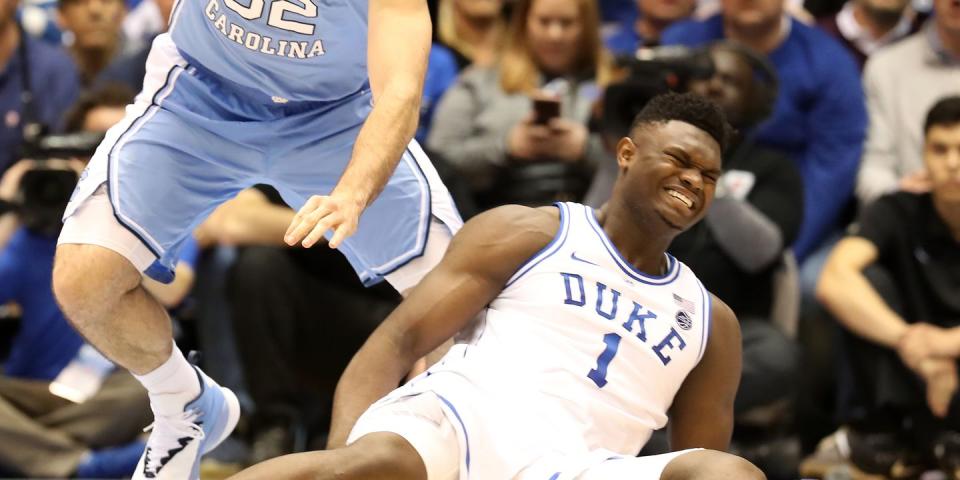The Shoe That Blew: Why Zion Williamson’s Nikes Came Apart

Call it the blowout heard ‘round the world.
Duke basketball superstar Zion Williamson was taking on North Carolina Wednesday night in one of the most-viewed college hoops games ever aired on ESPN when, just 33 seconds into the game, his shoes came flying apart. As the 6-7, 284-pound freshman planted his left foot on the hard maple floor at Cameron Indoor Stadium, the Duke-specific PG 2.5 - a signature model crafted for NBA star Paul George and one of the most-worn models in both college basketball and the NBA - gave out, with the upper ripping away from the midsole.

After Williamson left the game just 33 seconds into the contest, the shock waves spread around the sports world. Duke lost. Nike’s stock price dropped more than 1 percent the following day. And everybody, including the PG 2.5’s namesake player, was left wonder just how in the hell a shoe outfitting the presumptive number one pick in the NBA draft could come undone less than a minute into a basketball game.
“We are obviously concerned and want to wish Zion a speedy recovery,” Nike said in a statement. “The quality and performance of our products are of utmost importance. While this is an isolated occurrence, we are working to identify the issue.”
Obama was all over it. "His shoe broke" .
In what was possibly the most controversial shoe blow out of all time. Nike shares down 1.11% at the close of trade the following day. #ZionWilliamson #Duke #Nike pic.twitter.com/SIkjOTr8Lp- Sports Freakshow ⚽🏈🏉🏀⚾🏏 (@aussiebeastmode) February 21, 2019
Until Nike releases more details, we’re left to ponder what could have gone so wrong. The issue could come down to just how these special-edition Duke shoes were constructed, where they were made, or whether the titanic Williamson is simply too big for his sneakers (Paul George, by comparison, is 6-9, 220-pounds).
The blowout appeared to happen where the upper connects to the midsole. This kind of failure isn’t uncommon in athletic sneakers made with so-called Strobel construction. The Strobel method produces plenty of flex, and allows a sock-like feel by using a cloth connection to stitch the upper (the portion of the shoe that wraps the foot) to the midsole (the section that contains the cushioning). The midsole sits atop the traction-containing outsole, and the two are often cemented together.
Strobel construction offers overlock stitching to connect the sneaker’s last to the midsole for the more flexible and comfortable feel. But, as with any construction method, things can go wrong. Stitches can loosen, force can place too much pressure on stitching, or mistakes can happen at the factory.
For the PG 2.5, Nike designers used a half-bootie construction to secure the foot “with a streamlined fit.” (George now wears the just-released PG 3, although most NBA players and college teams are still donning the PG 2.5, which released in summer 2018.)
In press material released at the shoe’s launch, Nike says George’s game requires a shoe with a super-snug supportive feel. To enhance that support, designer Tony Hardman added a stretch zone in the forefoot, which adapts to George’s foot as he moves in shoes featuring thick mesh. Then the designer added “dynamic wings” over the top of the stretch zone for additional support. “It creates a nice hug,” he says.

In the midsole of the PG 2.5, Nike combined its Phylon foam with a Nike Air Zoom bag in the forefoot. “Reducing the weight suits [George’s] style of play. He’ll set and pop from three off of his forefoot and he’s doing a lot of cutting and slashing from the balls of his feet, both offensively and defensively,” Hardman says. “That softer midsole foam and the forefoot Zoom bag help him to generate more speed.”
On the Nike website, the company says the PG 2.5 is designed for the game’s most versatile players with a light, yet strong construction with a supportive strap and comfortable cushioning. For a player like Williamson, he may simply have been too much for the shoe-so powerful that some small construction issue could have caused the highest-profile shoe malfunction in NCAA history.
Follow Tim Newcomb on Twitter at @tdnewcomb.
('You Might Also Like',)
